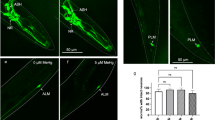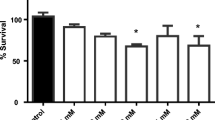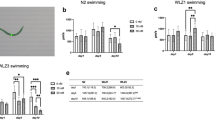Abstract
Nickel (Ni) is a ubiquitous metal in the environment with increasing industrial application. While environmental and occupational exposure to Ni compounds has been known to result in toxicities to several organs, including the liver, kidney, lungs, skin and gonads, neurotoxic effects have not been extensively investigated. In this present study, we investigated specific neuronal susceptibility in a C. elegans model of acute Ni neurotoxicity. Wild-type worms and worms expressing green fluorescent protein (GFP) in either cholinergic, dopaminergic or GABAergic neurons were treated with NiCl2 for 1 h at the first larval (L1) stage. The median lethal dose (LD50) was calculated to be 5.88 mM in this paradigm. Morphology studies of GFP-expressing worms showed significantly increasing degeneration of cholinergic, dopaminergic and GABAergic neurons with increasing Ni concentration. Significant functional changes in locomotion and basal slowing response assays reflected that cholinergic and dopaminergic neuronal function, respectively, were impaired due to Ni treatment. Interestingly, a small but significant number of worms exhibited shrinker phenotype upon Ni exposure but no loopy head foraging behaviour was observed suggesting that function of D-type GABAergic neurons of C elegans may be specifically attenuated while the RME subset of GABAergic neurons are not. GFP expression due to induction of glutathione S-transferase 4 (gst-4), a target of Nrf2 homolog skn-1, was increased in a Pgst-4::GFP worm highlighting Ni-induced oxidative stress. RT-qPCR verified upregulation of this expression of gst-4 immediately after exposure. These data suggest that oxidative stress is associated with neuronal damage and altered behaviour due to developmental Ni exposure.








Similar content being viewed by others
References
An JH, Blackwell TK (2003) SKN-1 links C. elegans mesendodermal specification to a conserved oxidative stress response. Genes Dev 17:1882–1893. https://doi.org/10.1101/gad.1107803
Andrade VM, Mateus ML, Batoreu MC, Aschner M, Marreilha dos Santos AP (2015) Lead, arsenic, and manganese metal mixture esposures: focus on biomarkers of effect. Biol Trace Elem Res 166:13–23. https://doi.org/10.1007/s12011-015-0267-x
ATSDR (2005) Toxicological profile for nickel. Atlanta, GA: U.S. Department of Health and Human Services, Public Health Service.
Au C, Benedetto A, Anderson J, Labrousse A, Erikson K, Ewbank JJ, Aschner M (2009) SMF-1, SMF-2 and SMF-3 DMT1 orthologues regulate and are regulated differentially by manganese levels in C. elegans. PLoS One 4:e7792. https://doi.org/10.1371/journal.pone.0007792
Blackwell TK, Steinbaugh MJ, Hourihan JM, Ewald CY, Isik M (2015) SKN-1/Nrf, stress responses, and aging in Caenorhabditis elegans Free Radic Biol Med 88:290–301. https://doi.org/10.1016/j.freeradbiomed.2015.06.008
Caito SW, Aschner M (2016) NAD+ supplementation attenuates methylmercury dopaminergic and mitochondrial toxicity in Caenorhabditis elegans. Toxicol Sci 151:139–149. https://doi.org/10.1093/toxsci/kfw030
Chakraborty S, Chen P, Bornhorst J, Schwerdtle T, Schumacher F, Kleuser B, Bowman AB, Aschner M (2015) Loss of pdr-1/parkin influences Mn homeostasis through altered ferroportin expression in C. elegans. Metallomics 7:847–856
Das K, Das S, Dhundasi S (2008) Nickel, its adverse health effects & oxidative stress. Indian J Med Res 128:412
Denkhaus E, Salnikow K (2002) Nickel essentiality, toxicity, and carcinogenicity. Crit Rev Oncol Hematol 42:35–56
Detienne G, Van de Walle P, De Haes W, Schoofs L, Temmerman L (2016) SKN-1-independent transcriptional activation of glutathione S-transferase 4 (GST-4) by EGF signaling. Worm 5:e1230585. https://doi.org/10.1080/21624054.2016.1230585
Garrick MD, Singleton ST, Vargas F, Kuo H, Zhao L, Knöpfel M, Davidson T, Costa M, Paradkar P, Roth JA (2006) DMT1: which metals does it transport? Biol Res 39:79–85
Gavet O, Pines J (2010) Progressive activation of CyclinB1-Cdk1 coordinates entry to mitosis. Dev Cell 18:533–543. https://doi.org/10.1016/j.devcel.2010.02.013
Gendrel M, Atlas EG, Hobert O (2016) A cellular and regulatory map of the GABAergic nervous system of C. elegans. Elife:5. https://doi.org/10.7554/eLife.17686
Hart AC (2006) Behavior (July 3, 2006), WormBook, ed. The C. elegans research community, WormBook, https://doi.org/10.1895/wormbook.1.87.1
He M, Xu S, Zhang X, Wang Y, Xiong J, Zhang X, Lu Y, Zhang L, Yu Z, Zhou Z (2013) Disturbance of aerobic metabolism accompanies neurobehavioral changes induced by nickel in mice. Neurotoxicology 38:9–16
Hunt PR (2017) The C. elegans model in toxicity testing. J Appl Toxicol 37:50–59. https://doi.org/10.1002/jat.3357
Ijomone OM, Miah MR, Peres TV, Nwoha PU, Aschner M (2016) Null allele mutants of trt-1, the catalytic subunit of telomerase in Caenorhabditis elegans, are less sensitive to Mn-induced toxicity and DAergic degeneration. Neurotoxicology 57:54–60. https://doi.org/10.1016/j.neuro.2016.08.016
Ijomone OM, Okori SO, Ijomone OK, Ebokaiwe AP (2018a) Sub-acute nickel exposure impairs behavior, alters neuronal microarchitecture, and induces oxidative stress in rats’ brain. Drug Chem Toxicol 41:377–384
Ijomone OM, Olatunji SY, Owolabi JO, Naicker T, Aschner M (2018b) Nickel-induced neurodegeneration in the hippocampus, striatum and cortex; an ultrastructural insight, and the role of caspase-3 and α-synuclein. J Trace Elem Med Biol 50:16–23
Jorgensen EM (2005) GABA (August 31, 2005), WormBook, ed. The C. elegans research community, WormBook, doi/https://doi.org/10.1895/wormbook. 1.14. 1
Liapi C, Zarros A, Theocharis S, Voumvourakis K, Anifantaki F, Gkrouzman E, Mellios Z, Skandali N, Al-Humadi H, Tsakiris S (2011) Short-term exposure to nickel alters the adult rat brain antioxidant status and the activities of crucial membrane-bound enzymes: neuroprotection by l-cysteine. Biol Trace Elem Res 143:1673–1681
Munoz A, Costa M (2012) Elucidating the mechanisms of nickel compound uptake: a review of particulate and nano-nickel endocytosis and toxicity. Toxicol Appl Pharmacol 260:1–16. https://doi.org/10.1016/j.taap.2011.12.014
Nass R, Hall DH, Miller DM 3rd, Blakely RD (2002) Neurotoxin-induced degeneration of dopamine neurons in Caenorhabditis elegans. Proc Natl Acad Sci U S A 99:3264–3269. https://doi.org/10.1073/pnas.042497999
Nieto A, Montaruli V, Cardu M (2013) The strategic importance of nickel: scenarios and perspectives aimed at global supply. Trans Soc Min, Metall, Explor 332:510–518
Park SK, Tedesco PM, Johnson TE (2009) Oxidative stress and longevity in Caenorhabditis elegans as mediated by SKN-1. Aging Cell 8:258–269. https://doi.org/10.1111/j.1474-9726.2009.00473.x
Rand JB (2007) Acetylcholine (January 30, 2007), WormBook, ed. The C. elegans research community, WormBook, doi/https://doi.org/10.1895/wormbook. 1.131. 1
Ruszkiewicz JA, Bowman AB, Farina M, Rocha JBT, Aschner M (2016) Sex- and structure-specific differences in antioxidant responses to methylmercury during early development. Neurotoxicology 56:118–126. https://doi.org/10.1016/j.neuro.2016.07.009
Sawin ER, Ranganathan R, Horvitz HR (2000) C. elegans locomotory rate is modulated by the environment through a dopaminergic pathway and by experience through a serotonergic pathway. Neuron 26:619–631. https://doi.org/10.1016/s0896-6273(00)81199-x
Udeme JD, Etim IU (2012) Physicochemical studies of Nigeria’s crude oil blends. In: Petroleum and coal, In, pp 243–251
Zhang Y, Chen D, Smith MA, Zhang B, Pan X (2012) Selection of reliable reference genes in Caenorhabditis elegans for analysis of nanotoxicity. PLoS One 7:e31849. https://doi.org/10.1371/journal.pone.0031849
Acknowledgements
The authors acknowledge the Analytical Imaging Facility, Albert Einstein College of Medicine, USA (NCI: P30CA013330).
Funding
OMI acknowledges the support of International Brain Research Organization (IBRO)-International Society for Neurochemistry (ISN) Research Fellowship 2017. MA was supported by National Institute of Health (NIH) R01 ES10563, R01 ES07331 and R01 ES020852.
Author information
Authors and Affiliations
Corresponding authors
Ethics declarations
Conflict of Interests
The authors declare no conflict of interests.
Additional information
Publisher’s Note
Springer Nature remains neutral with regard to jurisdictional claims in published maps and institutional affiliations.
Rights and permissions
About this article
Cite this article
Ijomone, O.M., Miah, M.R., Akingbade, G.T. et al. Nickel-Induced Developmental Neurotoxicity in C. elegans Includes Cholinergic, Dopaminergic and GABAergic Degeneration, Altered Behaviour, and Increased SKN-1 Activity. Neurotox Res 37, 1018–1028 (2020). https://doi.org/10.1007/s12640-020-00175-3
Received:
Revised:
Accepted:
Published:
Issue Date:
DOI: https://doi.org/10.1007/s12640-020-00175-3




